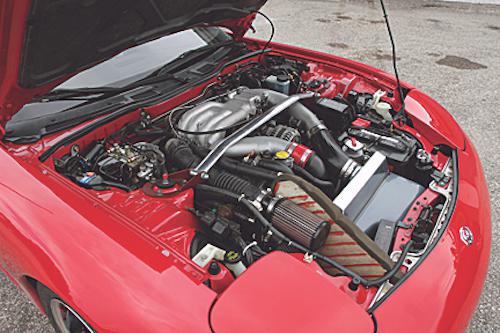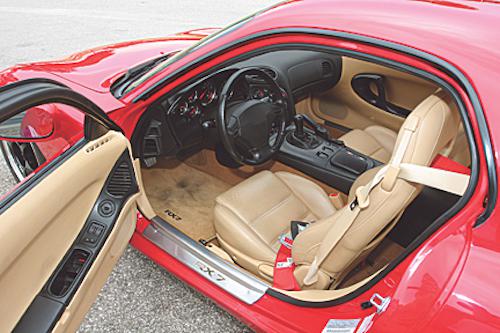It's not easy being different. Just about every car manufacturer has made some form of sports car, and each marque has tried a different tack to make its steed stand out from the herd. Only one manufacturer, however, managed to outshine the rest from day one with something truly unusual.
Running Man
The third-generation RX-7 remained basically the same during its entire U.S. model run with four basic models available: Base, Touring, Popular Equipment Package (PEP), plus the R1 and later R2 performance packages. Each trim level grouped together specific options until 1994, when Mazda allowed individual options to be ordered.
The R1 was the automotive cocktail for the hardcore driver. The package added a stiffer suspension and other performance items; Mazda only sold it during 1993. The R2 replaced the R1 for the next model year due to complaints that the R1 was too stiff.
Unlike previous generations, only one engine was available for the third-generation RX-7. The car’s 13B rotary engine sported a very complex twin sequential turbocharger system where in each turbo had a specific purpose in life: The first one helped low-end torque and around 4500 rpm the second one kicked in for high-rpm power. In stock trim, both turbos produce 10 psi of boost, but during the changeover the boost drops to 8 psi, resulting in a 10-8-10 pattern.
Maximum output was listed as 255 horsepower. When combined with the car’s 2800-pound fighting weight, the resulting performance was stellar.
Collateral Damage
While the car sounds infallible on paper, there are several potential hazards to keep in mind before running out and handing over a check for a third-generation RX-7. Although a prospective purchase should be inspected just like any other used car, there are some special things to consider on a rotary car, particularly an FD.
For one, if it's at all possible, have a rotary specialist do an inspection. Rotary specialists know their way around under the hood, and they should have the proper equipment and knowledge to check engine compression and uncover any other issues.
What about a local Mazda dealer? Well, it’s now been 12 years since Mazda sold their last new RX-7. Don’t be too surprised when they also recommend an independent shop.
Even though the cars are somewhat complex, there are some simple aspects to check out during an initial inspection. If the car fails on these points, then you saved yourself the cost of getting a professional opinion.
The rotary engine is particularly sensitive to heat, and adding two turbos under the hood doesn’t help matters. In many FD chassis RX-7s, the needle in the water temperature gauge lacks sensitivity, and what appears to be slightly warmer than normal can actually be well above the safe operating temperature. The car could have overheated and the owner would not have noticed because the gauge would have pointed just off center, not in the “hot” zone.
Once the car is warmed up, the gauge should point just below horizontal. If the engine has, in fact, overheated, it’s a ticking time bomb in terms of reliability. It’s only a matter of time before it breaks.
Another item to take note of is the oil pressure gauge. The sending unit can be faulty, creating an erroneous reading on the gauge that usually appears as no pressure at idle. This reading is particularly suspicious, as the oil pressure itself is usually good thanks to the RX-7’s stout oil pump. Installing a quality aftermarket gauge or new sender will fix the error.
A simple test drive should also uncover any major issues. If it smokes after warm-up, then you have a problem. Run.

Photography Credit: David S. Wallens
Total Recall
There were three factory recalls for the third generation RX-7. The first dealt with a vacuum hose modification for the brakes. The next replaced the fuel lines under the hood with parts that could handle higher temps. The last dealt with the cooling system, swapping out the fan control module and also replacing the radiator cap to lower the pressure in the system.
To easily find out if these recall procedures have been performed, look for the appropriate service stickers in the driver’s side door jamb. If there are no stickers to be found, that doesn’t necessarily mean the recall issue wasn’t fixed. A call to Mazda Customer Relations with the VIN should get the answer.
Red Heat
An FD can be a reliable car. It just requires a little more love than a typical Honda. Third-generation RX-7s have a bad reputation for reliability, in part thanks to their relatively packed maintenance schedule and the difficulty that comes with performing some of the basic jobs.
A rotary engine makes a lot of heat on its own. Add twin turbochargers, and it becomes fairly easy to see why so many FDs languish in driveways instead of cruising down the road. Heat management is the number one priority for keeping these cars running strong.
Ensuring that the cooling system is working properly is a key step to preventing too much heat. The stock plastic air separation tank is known to split down the seams. Replacing this with a solid aftermarket unit or cutting it out completely reduces the chance of a messy situation.
A rotary burns a small amount of oil in each combustion cycle. It is important to make sure that the oil is topped off frequently and that it remains cool. The factory installed an oil cooler from the get-go, and the R-packaged cars received two of them. Make sure the oil cooler is intact and getting good airflow. Routine oil changes are also crucial for preventing the oil coolers from clogging and for keeping the seals in good shape.
Fuel helps keep the engine temps down, and getting enough of this precious nectar into a rotary is paramount. Some aftermarket upgrades lean the mixture too much and can possibly break apex seals.
The fuel filter can also create issues if it gets clogged. Replacing the fuel filter regularly will help make sure that a lean condition doesn’t happen. The tough part is getting at the filter, as it lives above the rear differential.
Replacing the fuel filter takes less than 10 minutes with the differential out of the way. However, with the differential in place, it can be an hour-plus job. As a result, a lot of RX-7s didn’t get their routine, required fuel filter changes. Since there are some differential bushings that go bad over time, removing the differential and servicing that end of the car might not be a bad weekend project.
Keeping maintenance up to date will make any FD a happy car worth driving. And keeping the car running strong means that bolt-on performance parts work even better and can greatly enhance the car’s overall performance.
End of Days
The FD chassis RX-7 was and still is a favorite among enthusiasts, but that couldn’t keep the car from being terminated. The rotary also left Mazda’s lineup briefly until the recent introduction of the RX-8.
True, today an RX-7 requires a little more love and attention than some of its peers, but the payoff is a truly wonderful car that will run well and keep going for a long time. Minor modifications to ensure reliability in the long run pay dividends when it comes to future mods for power and handling.
With some simple modifications, the power potential climbs. Well established message boards on the Web help RX-7 newcomers transition smoothly into driving a car powered by “magical spinning triangles” and provide a huge knowledge base for any issue that might arise.

Photography Credit: David S. Wallens
Things to Know
Despite the short production run, finding a third-generation Mazda RX-7 for sale isn’t too hard. Finding a good one, however, can take some searching. Many of these cars have led tough lives, and right now there’s no shortage of non-runners listed for sale. Spend a little time on a thorough investigation to find one of quality.
Chassis
- The R1 and R2 equipped cars are the sportier models that received stiffer suspension parts from the factory.
- Double-check the wheels on early production cars. Mazda changed wheel manufacturers halfway through the 1993 production year because the earlier pieces had a tendency to crack.
- Some early production cars make a clunking noise in the suspension. This is usually caused by a noisy upper A-arm bushing which can be replaced, but the part is expensive.
- The stock wheels have a relatively high offset (50 mm) for a rear-wheel-drive car. Given the correct backspacing, up to 10-inch-wide wheels can fit under the stock rear fenders
Drivetrain
- The fifth gear synchro is a weak link. You will know it’s going bad because there will be a grinding noise when shifting into fifth. Replacement parts are cheap, but labor is expensive.
- A Torsen differential is standard, but there are also aftermarket clutch-type differentials available.
- The transmission and rear end are tied together with Mazda's proprietary Power Plant Frame made of stamped steel. Mazdaspeed offers a stiffer one to help reduce driveline flex.
- A popular modification is a lightweight flywheel. However, using one that is too light in a daily driver could make the car tough to live with, as accelerating from a dead stop becomes a bit clumsy.
Engine
- In some cars there is a slight hesitation under light throttle around 3000 rpm. There are several explanations and fixes for this problem, and the results are mixed. No one seems to know exactly why it happens.
- Vacuum lines and hoses can become brittle and break thanks to the underhood temperatures. Replacing the lines with quality silicone pieces or other materials that handle high heat will fix the problem. Once again, the parts needed for the fix are inexpensive; the same cannot be said for the labor.
- The turbochargers’ coolant lines need to be checked to make sure they are intact. Replace them if needed.
- The exhaust system is complex and has numerous pieces. There are two catalytic converters, and the front one has a bad habit of melting and clogging the exhaust. If you can get away with it, simply running a downpipe off of the turbos fixes the issue.
- Proper belt tension is critical for water pump longevity, which is in turn critical to keeping the engine from overheating.
- The fuel filter is inconveniently located above the rear differential, making it a pain to access. We don’t care how much the job stinks; replace the fuel filter on a regular basis.
Body and Interior
- Some cars had issues with the exterior paint not bonding well with the primer. Nowadays, this often shows as faded or chipped paint. Cars stored outside seem to have the most problems.
- The temp gauge is not very accurate. An aftermarket gauge that shows the actual temperature is in the car’s best interest.
- The oil pressure gauge and sender can have issues. Once again, a quality aftermarket sender and gauge will give accurate readings.
- The dash and other interior panels were coated with a material that can peel off. Most cars had this problem corrected under warranty.
- The factory never installed a boost gauge. Wacky, huh? Adding one is a good idea.

Photography Credit: euroimage.us
Like what you're reading? We rely on your financial support. For as little as $3, you can support Grassroots Motorsports by becoming a Patron today.








































